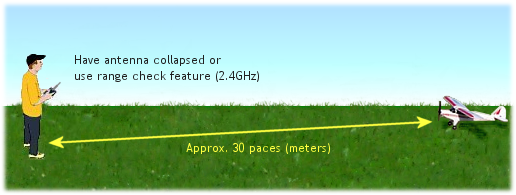RC Airplane World flight school
- lesson #6 : pre-flight checks
Following on from lesson 5, this rc flight school page will teach you about the important rc airplane pre-flight checks that you need to perform before you fly your plane.
The purpose of pre-flight checks is to ensure that your rc plane is in a fit condition to fly, and that everything is working as it should be. Exact pre-flight checks might differ from plane to plane, but there are some fundamental checks that all rc airplanes need to have done, immediately before flight.
If you neglect to carry out the pre-flight checks before you fly your rc airplane, and something is badly amiss, then an avoidable crash is very likely. Many rc pilots have lost their beloved aircraft seconds after take off, simply because they didn't do the checks!
Your first and foremost point of reference for the exact pre-flight checks needed for your particular airplane should be the instruction manual (DVD or CD ROM) that came with the plane. But, failing that, listed below (in no particular order) are the minimum checks that you need to carry out before you take off...
- All servos are secure, and linkages to servo and control surfaces are secure.
- Servo horns and control horns are secure and not loose.
- Servo linkages are able to move freely and are not binding.
- All servo connections to the receiver, battery pack and ESC are secure and correct.
- The receiver and motor battery pack are securely fixed and cannot move during flight.
- Receiver antenna (aerial) is correctly positioned and not damaged.
- The propeller nut is tight / spinner is secure.
- The wing and tailplane (and fin) are secured properly, as per the instructions (i.e. with the correct method of fixing; rubber bands or wing nuts etc.)
- All control surfaces move in the correct sense eg moving the rudder stick left moves the rudder to the left.
- All control surface hinges are secure i.e. you can't pull the control surface away from its respective flying surface.
- The motor power works correctly.
- The radio failsafe is set and working correctly.
- A range check.
This last one, the range check, is very important so we'll cover it in more detail...
The purpose of the range check is to make sure the radio signal from transmitter to receiver is strong, so that you can fly your rc airplane at a normal distance away from you without it going out of radio range. If your plane does go out of range, then you lose all control.
Perform a range check with a MHz radio system thus:
Switch on the transmitter then the receiver, and with the transmitter antenna fully collapsed (i.e. down), walk backwards away from the airplane for 30 paces or so. As you walk away from the plane, keep moving the control surface sticks of the Tx (not the motor - keep that stick fully down!) and closely watch the respective control surfaces of the airplane.

Above: an rc airplane range check should be done at a distance of
30 paces (meters) or so away from the plane.
If you only get a short distance away and the surfaces start 'twitching' or not responding properly to your stick movements, do not fly. Check the batteries of the radio gear, they may need replacing - low batteries in the transmitter drastically reduce the radio range. Also check for loose connections to the receiver etc., and also the condition of the antenna(s).
If the batteries and connections are OK but the control surfaces still don't respond properly, then other people may be using your frequency nearby. Again, do not fly if this is the case. Interference is a big killer of rc airplanes, and you need to be sure that your frequency is clear before you get airborne.
An rc airplane range check with a 2.4GHz radio system is slightly different, in that the antenna cannot be collapsed. You will have to refer to your radio instruction manual to see the correct range check procedure for your exact radio, as different manufacturers use different methods of activating the range check mode in a 2.4GHz radio.
Whichever method is involved, a 2.4GHz transmitter in range check mode sends out the signals with a reduced voltage, thus producing a weaker signal.
The rest of the check is performed in the same way as explained above.
Regardless of whether you have a MHz or 2.4GHz system, do not fly your plane if you see that control surface response becomes unreliable before you reach 30 paces or so away from the plane. You need to identify and rectify before you fly!
Always always always take a few minutes to perform these rc airplane pre-flight checks before you commence your flying session. Get in to the habit of pre-flighting your plane every time; the checks take just a couple of minutes to do and will save you the grief of a crashed airplane, if something is amiss.
![]() Next up: Lesson 7 - Taking off / hand launching your rc airplane!
Next up: Lesson 7 - Taking off / hand launching your rc airplane!
Or skip to the lesson appropriate to your current situation...
- Lesson 1: Buying your rc airplane.
- Lesson 2: Know your rc airplane.
- Lesson 3: Preparing your plane.
- Lesson 4: Weight and balance.
- Lesson 5: Where to fly your plane.
- Lesson 7: Take off / hand launch.
- Lesson 8: Flying your rc airplane.
- Lesson 9: Landing your rc airplane.
